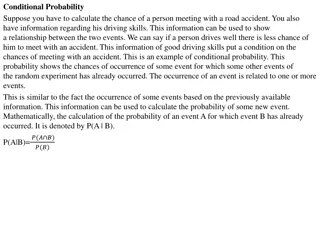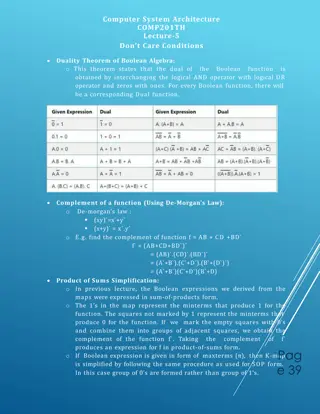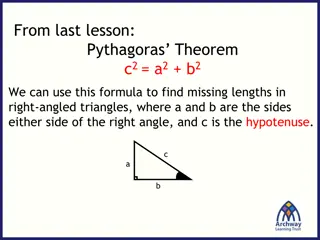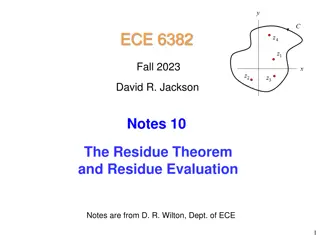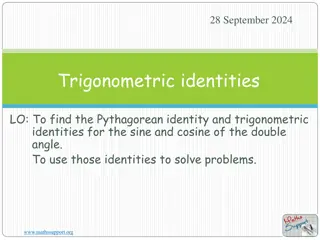Exploring the Pythagorean Theorem and Its Origins
The Pythagorean Theorem, named after the ancient Greek mathematician Pythagoras, is a fundamental principle in geometry relating to right triangles. While Pythagoras is credited with offering a proof of the theorem, evidence suggests that earlier civilizations like the Babylonians and ancient Chinese also understood this geometric relationship. Pythagoras, known not only as a mathematician but also as a philosopher, believed in the harmony of the world expressed through numerical relationships. This theorem states that in a right triangle, the square of the hypotenuse is equal to the sum of the squares of the other two sides. Let's delve into the history and significance of this theorem!
Download Presentation

Please find below an Image/Link to download the presentation.
The content on the website is provided AS IS for your information and personal use only. It may not be sold, licensed, or shared on other websites without obtaining consent from the author.If you encounter any issues during the download, it is possible that the publisher has removed the file from their server.
You are allowed to download the files provided on this website for personal or commercial use, subject to the condition that they are used lawfully. All files are the property of their respective owners.
The content on the website is provided AS IS for your information and personal use only. It may not be sold, licensed, or shared on other websites without obtaining consent from the author.
E N D
Presentation Transcript
The Pythagorean Theorem takes its name from the ancient Greek mathematician Pythagoras (569 B.C.?-500 B.C.?), who was perhaps the first to offer a proof of the theorem. But people had noticed the special relationship between the sides of a right triangle long before Pythagoras.
There is evidence that the Babylonians, more than 1000 years before Pythagoras, understood the relationship between the sides of a right triangle. There is also evidence that ancient Chinese philosophers understood the relationship between the sides of the right triangle around the same time as Pythagoras.
Pythagoras himself was not simply a mathematician. He was an important philosopher who believed that the world was ruled by harmony and that numerical relationships could best express this harmony. He was the first, for example, to represent musical harmonies as simple ratios.
We do not know for sure how Pythagoras himself proved the theorem that bears his name because he refused to allow his teachings to be recorded in writing. But probably, like most ancient proofs of the Pythagorean Theorem, it was geometrical in nature. Today, we will prove the Pythagorean Theorem!
First, the Pythagorean Theorem only works in right triangles.
The longest side of a right triangle that is opposite the right angle (the largest angle) is called the hypotenuse and usually labeled side c . hypotenuse c The two sides that are adjacent to the right angle are called the legs and are labeled sides a and b a b legs
The Pythagorean Theorem states that the sum of the square of the legs of a right triangle is equal to the square of the hypotenuse. ??+ ??= ??
If a = 6 and b = 8, find c. If a = 8cm and b = 15cm, find c.
If c = 13 and b = 12, find a. If c = 26m and a = 24m, find b.
The Pythagorean Theorem has many real-world applications. It commonly used in the day to day life of Engineers Architects Construction Workers Criminal Forensic Scientists NASA Scientists
The theorem can be used to figure out the height of a wall the breadth of a river the depth of a lake the trajectory of a bullet the location of an airplane GPS (Global Positioning System)
Advancements in technology have enabled computers to calculate many things that relate to the Pythagorean Theorem such as location. Google Earth can calculate the exact location of any places using a process called triangulation. https://encrypted-tbn1.gstatic.com/images?q=tbn:ANd9GcSXNI7In3OzNzhVY7nBQsWXMoTXfoJyjUbBvQys-kjRUC9fIW6DQ378xF7h
Triangulation is a method used for pinpointing a location with two known reference points. When Triangulation is used with a 90- degree angle, the Pythagorean Theorem is used to determine the location. More advanced levels of triangulation are based on Trigonometric Laws that apply to all triangles, not just right triangles.
You've just picked up a ground ball at first base, and you see the other team's player running towards third base. How far do you have to throw the ball to get it from first base to third base, and throw the runner out?
You're locked out of your house and the only open window is on the second floor, 24 feet above the ground. You need to borrow a ladder from one of your neighbors. There's a bush along the edge of the house, so you'll have to place the ladder 10 feet from the house. What length of ladder do you need to reach the window?
The city has decided to construct a new skateboard ramp for the skateboard park. The space available will allow a ramp to be 25 feet deep, 7 feet tall and span 5 feet across. To the nearest foot, how long will the ramp be? 12 feet 7 feet ??? 25 feet
20% Off Flagpoles Aluminum Fiberglass In-Ground Styles The line attached to the top of a flagpole is 100 feet long. When the free end of the line is placed on the ground, it is 60 feet from the base of the flag pole. How high is the flag pole?


